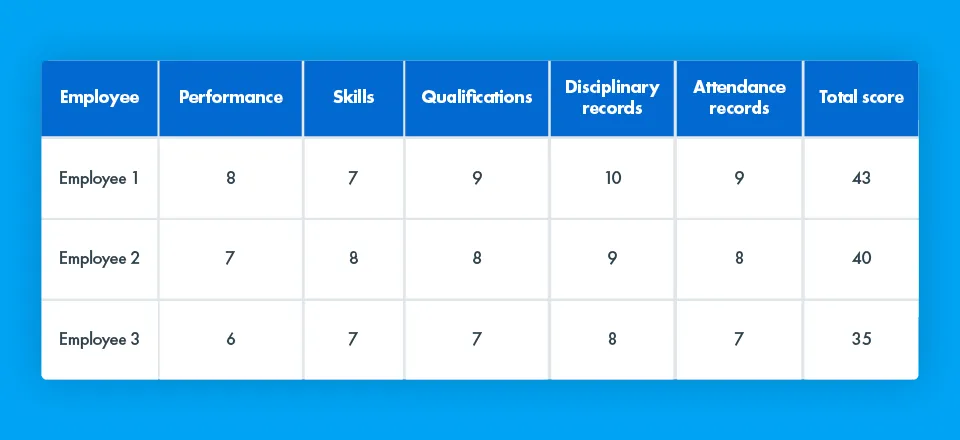Selection criteria for redundancy – all you need to know from an HR expert

Making people redundant is never a good feeling – neither for you nor for the employee being let go. However, hard decisions sometimes have to be made for your business and they often fall onto us as HR professionals.
Redundancy selection criteria creates many of the opposite feelings we wish to cultivate as HR professionals – anxiety, disappointment, hurt, inadequacy, and failure.
Making people redundant is not the fun or fulfilling part of what I do, but it's occasionally necessary for any business that goes through hard times. Having a clear, fair redundancy process helps minimise the potential harm to both your company and the team member being made redundant.
For small businesses preparing for a round of redundancies – have a read at how you can understand what the selection criteria for redundancy is and how to make sure you stay legally compliant whilst doing it.
Understanding what redundancy is
Before I get into the specifics of redundancy selection criteria, we must understand the difference between redundancy and dismissal.
- Redundancy (which can also be voluntary redundancy) is a form of dismissal that happens when an employer needs to reduce their workforce for reasons that are outside the employee’s control, and for reasons that are not their fault. This could be for one of several reasons, like economic downturn, business restructuring, or the business shutting up shop.
- Firing an employee, by contrast, is the result of an employee’s poor performance or behaviour.
Making redundancies has legal as well as ethical implications. For one thing, sloppy or biased redundancies can lead to unfair dismissal lawsuits if not handled properly. Further, a poorly managed redundancy selection can damage your employee’s morale and their trust in you.
That’s why it’s so important that we strive to handle redundancies with care, empathy, and fairness by having the right redundancy selection criteria so that we can help create a positive work atmosphere during difficult times.
We also couldn't recommend enough to subscribe to an employer's liability insurance to cover your business and ensure you're protected.
Identifying the redundancy pool
The first step is to identify the group of candidates from which redundancies will be made. This is known as your “redundancy pool.”
Creating your business’s redundancy pool is not a one-size-fits-all process. It requires consideration of factors such as the type of work the employees do, their skills and qualifications, and the needs of the business.
The pool of redundancy candidates may be determined by any roles, departments and areas of the business that are being phased out.
Remember, the selection criteria for the redundancy should be objective and justifiable. It’s also important that you communicate the redundancies with employees early on and the reasons behind them, rather than blindside them out of the blue.
Defining the redundancy selection criteria
Once you made your redundancy pool and selected your candidates, it’s time to define your selection criteria for redundancy.
The criteria you use to determine which candidates are made redundant should be clearly defined, consistently applied throughout the process, and justifiable from a business perspective.
Common redundancy criteria include:
- skills
- qualifications
- disciplinary records
- attendance records
- employee’s ability to perform their role
Above all, the criteria should be unbiased and nondiscriminatory. It should not be based on subjective or protected characteristics like age, gender, ethnicity, disability, or pregnancy. Always make sure that your selection criteria are in line with equality and anti-discrimination laws.
To do that, it may be helpful to get the help of a qualified HR expert like the ones on my team – we can give you ad-hoc advice at any time for all situations, including redundancies. Maybe it’s time to book a call with us today to find out more, avoid any legal complications and follow HR compliance on the matter.
Using a matrix for your redundancy selection criteria
You must make your selection criteria for redundancy as unbiased and objective as possible. For this reason, I’d recommend visualising your process in a redundancy matrix.
A redundancy matrix is a grid you can use to score employees against your criteria. It's a methodical approach that can be used during the redundancy consultation phase of the process when you speak with those employees who are at risk - and it offers a record of how the decision was made.
Here’s how you would go about making a redundancy matrix:
- Identify the criteria: Use the criteria you identified previously, e.g. performance, skills, and disciplinary records
- Score employees against the criteria: Score employees against the criteria, numerically. This should be done fairly and consistently based on data rather than personal opinions and experiences
- Make the decision based on the scores: Once the employees have been scored, it’s decision time. The decisions on who is made redundant and who gets to stay should be based on the scores, with employees with the lowest scores being selected for redundancy
- Keep a record of the process: It's important to keep a documented record of the redundancy process. You need to have something to refer back to when you need to demonstrate that the process was fair and transparent, and it can be especially useful in case of legal trouble.
Your redundancy matrix might look like this:

Redundancy selection criteria makes difficult choices easier
It makes my heart sink whenever I have to guide a small business through painful, but necessary, redundancies. Implementing fair and transparent redundancy selection criteria makes these hard choices easier.
When you use objective redundancy selection criteria and a redundancy matrix to back up your choices with confidence and objective data, you can help make the best decisions for both you and your team.
Redundancies are tricky and delicate situations that are very easy to get wrong. Here’s how we, at CharlieHR, can help you do:
- Avoid redundancies unless they are truly necessary and unavoidable
- Help you with the redundancy selection criteria
- Flag any potential discrimination or bias
- Guide you through writing redundancy letters to handle the redundancy with professionalism and empathy
Book an intro call with our HR advice sales team, and we’ll help you get through this challenging situation with peace of mind.

Want to find out more about HR compliance? Check out our complete guides on topics such as:


